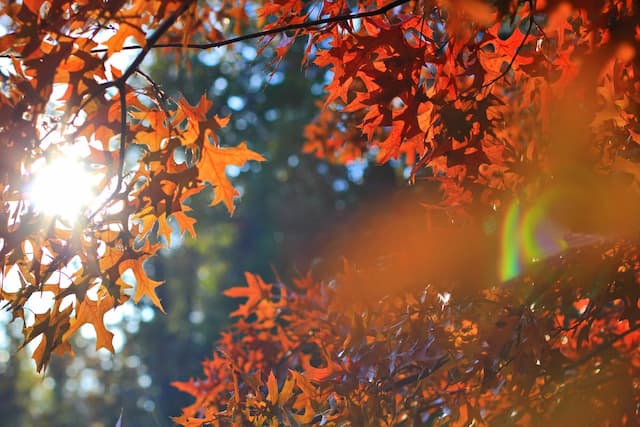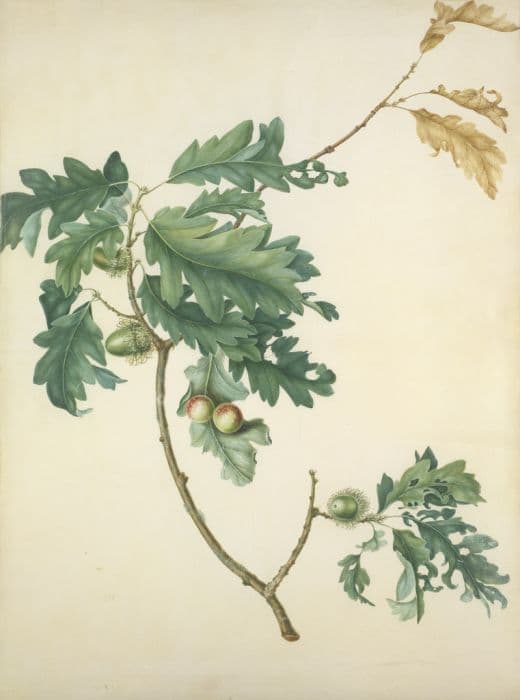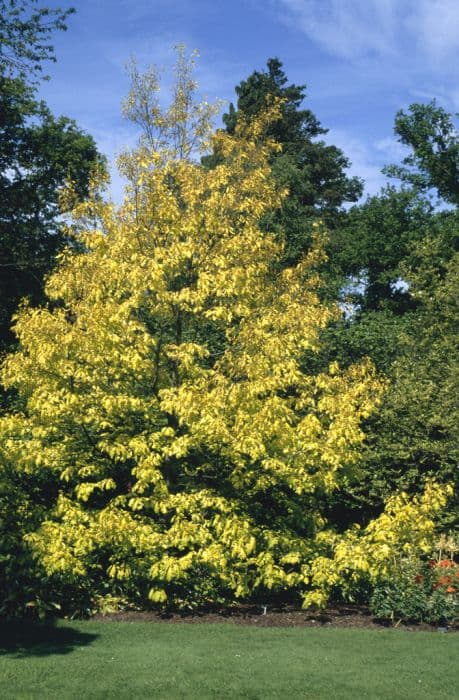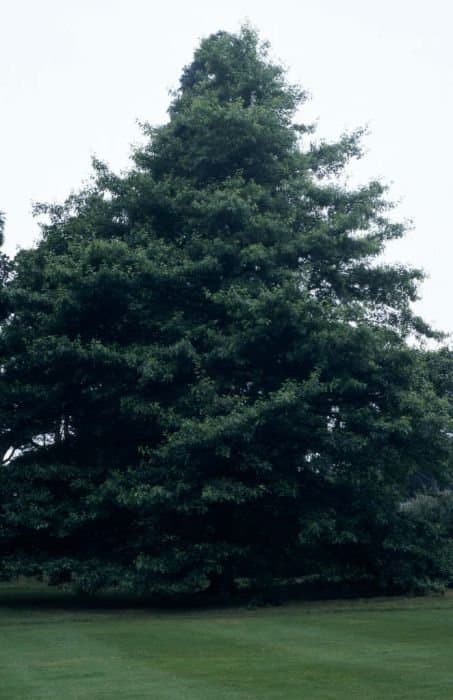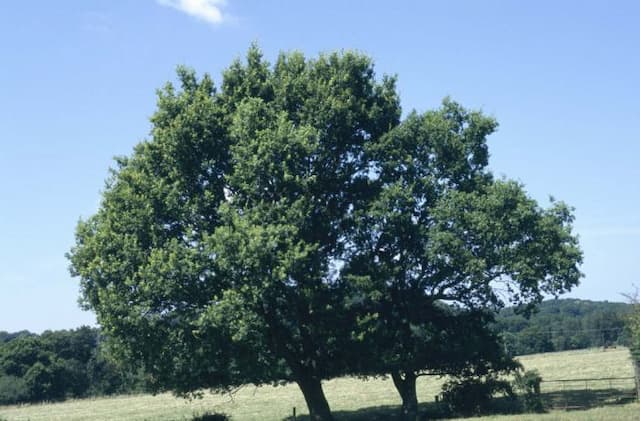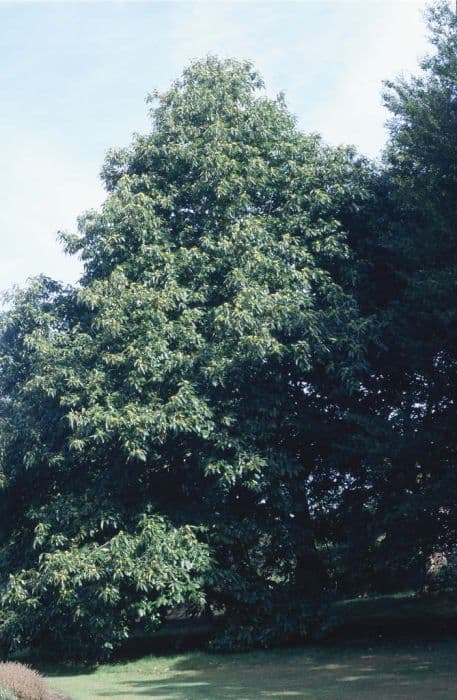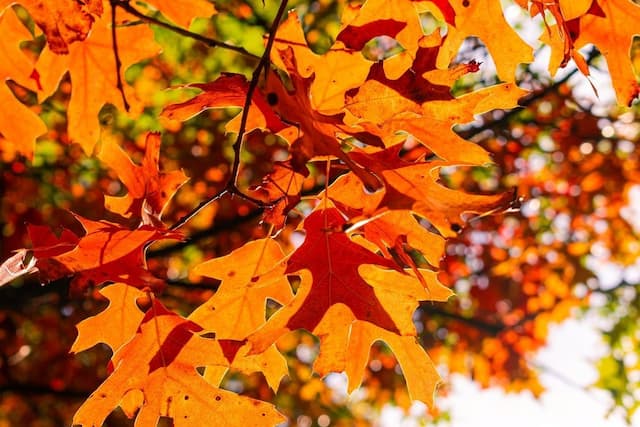Loquat-leaf Oak Quercus rysophylla
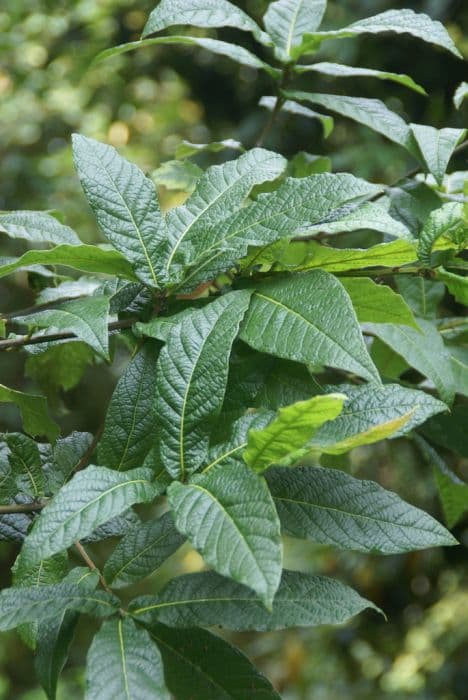
ABOUT
The plant commonly known as Loquat-leaf Oak is adorned with a striking foliage that features elongated, glossy leaves with pointed tips. Its leaves are distinctive as they bear resemblance to those of a loquat, showcasing a leathery texture. The top side of the leaves presents a deep green hue, while the underside reveals a contrasting lighter, often fuzzy texture. This unique leaf coloration contributes to its ornamental appeal. The edges of the leaves are typically smooth, and they might sometimes show a slight waviness, adding to the plant's visual interest. In addition to its impressive leaves, the Loquat-leaf Oak produces an attractive display of catkins, which are long, slender flower clusters that dangle gracefully from the branches. The bark of this oak is also noteworthy, exhibiting a rich texture that adds to the overall aesthetics of the tree. As seasons change, so does the color palette of the foliage, offering a dynamic range of colors through the year. This combination of features makes the Loquat-leaf Oak a valuable specimen for visual interest in landscape design.
About this plant
 Names
NamesFamily
Fagaceae
Synonyms
Loquat Oak, Mayab Oak, Bastard Oak
Common names
Quercus sagraeana, Quercus oleoides var. sagraeana.
 Toxicity
ToxicityTo humans
Quercus rysophylla, commonly known as Loquatleaf Oak, is not commonly listed as a toxic plant to humans. Oaks can produce tannins, which in large amounts may cause stomach upset, nausea, vomiting, or diarrhea if ingested in significant quantities, but generally, they are not considered poisonous to people. It is, however, always recommended to exercise caution and not consume parts of ornamental plants unless they are known to be safe for consumption.
To pets
Quercus rysophylla, known as Loquatleaf Oak, has parts that are potentially toxic to pets, specifically to cats, dogs, and horses. The ingestion of acorns or oak leaves in significant amounts can cause poisoning due to the tannins present. Symptoms of Oak poisoning in pets can include vomiting, diarrhea, abdominal pain, reduced appetite, and kidney damage in severe cases. Ingesting small quantities typically only results in mild gastrointestinal upset, but consumption of large amounts requires veterinary attention.
 Characteristics
CharacteristicsLife cycle
Perennials
Foliage type
Deciduous
Color of leaves
Green
Height
30 feet [9 meters]
Spread
30 feet [9 meters]
Plant type
Tree
Hardiness zones
7
Native area
Mexico
Benefits
 General Benefits
General Benefits- Wildlife Habitat: Provides food and shelter for various species of wildlife, including birds and squirrels.
- Soil Conservation: Helps to prevent soil erosion with its extensive root system.
- Ecosystem Services: Plays a role in maintaining the ecological balance of its native habitat.
- Landscape Improvement: Can be used in landscaping for aesthetic purposes and to provide shade.
- Carbon Sequestration: Contributes to the sequestration of carbon dioxide, helping mitigate climate change.
- Water Regulation: Its roots can help regulate water flow and improve groundwater recharge.
- Cultural Significance: May hold cultural importance in certain regions or for specific communities.
 Medical Properties
Medical PropertiesThis plant is not used for medical purposes.
 Air-purifying Qualities
Air-purifying QualitiesThis plant is not specifically known for air purifying qualities.
 Other Uses
Other Uses- Lozano oak bark has been traditionally used for tanning leather due to its tannin content, which helps to preserve the leather and provide durability.
- The wood of the Lozano oak is valued for its hardness and density, making it suitable for crafting furniture and other woodworking projects that require sturdy materials.
- The acorns of the Lozano oak can be ground into flour after leaching out the tannins, providing a source of food in traditional cuisines.
- In landscape architecture, the Lozano oak is planted as an ornamental shade tree due to its aesthetic foliage and overall majestic appearance.
- The tree's wood chips can be used as a mulching material in gardens, helping to conserve soil moisture and suppress weeds.
- Lozano oak leaves can be used as a natural dye for textiles, imparting a range of brown tones depending on the mordant used.
- The acorns can serve as a feed for wildlife or livestock, especially pigs, which can fatten on this rich source of carbohydrates and fats.
- In some regions, the Lozano oak is utilized in agroforestry systems, where it is interplanted with crops to enhance biodiversity and soil health.
- The sawdust from Lozano oak can be used as a component in the substrate for cultivating certain types of mushrooms, such as shitake.
- The tree's strong branches are sometimes harvested and used as natural walking sticks or in the construction of rustic outdoor furniture.
Interesting Facts
 Feng Shui
Feng ShuiThe Loquat is not used in Feng Shui practice.
 Zodiac Sign Compitability
Zodiac Sign CompitabilityThe Loquat is not used in astrology practice.
 Plant Symbolism
Plant Symbolism- Strength and Endurance: Quercus rysophylla, commonly known as Loquat-leaf Oak, symbolizes strength and endurance due to oaks being associated with robustness and the ability to withstand harsh conditions.
- Wisdom: Oaks, in general, have been regarded as symbols of wisdom and knowledge, representing the deep-rooted wisdom of nature that Loquat-leaf Oak shares.
- Nobility: The oak tree has been a symbol of nobility and honor, often associated with rulers and gods, suggesting that Loquat-leaf Oak can also represent these noble qualities.
- Stability: The solid trunk and extensive root system often lead to oak trees being seen as a symbol of stability and reliability, qualities that are mirrored in the Loquat-leaf Oak.
- Resilience: Loquat-leaf Oak, like other oaks, may represent resilience because it can survive in various environments and recover from challenges.
 Water
WaterThe Loquat-leaf Oak should be watered thoroughly when the top 2-3 inches of soil feel dry to the touch. During the growing season, it may need watering approximately once a week, but always check the soil moisture before watering. The amount of water needed at each watering can be about 1-2 gallons for a young tree, increasing as the tree matures and depending on the size and root system. In the winter, reduce watering frequency as the tree’s growth slows down. Ensure that the water penetrates deeply into the soil to encourage a robust root system.
 Light
LightThe Loquat-leaf Oak prefers full sun to partial shade conditions. It thrives best when planted in a location that receives at least six hours of direct sunlight daily but can also tolerate some light afternoon shade.
 Temperature
TemperatureThe Loquat-leaf Oak is adapted to a range of temperatures but grows best in conditions between 50°F and 80°F. It can survive minimum temperatures down to 20°F, but growth may be stunted or damaged if temperatures fall below this point. It is important to protect the tree from extreme cold and frost.
 Pruning
PruningPruning the Loquat-leaf Oak is important for maintaining tree health and structure, and should be done in late winter before the spring growth starts. Remove any dead, damaged, or diseased branches, as well as any that cross or rub against each other. Pruning every 2-3 years is typically sufficient unless there are specific structural issues that need to be addressed more frequently.
 Cleaning
CleaningAs needed
 Soil
SoilThe best soil mix for the Loquat-leaved Oak (Quercus rysophylla) should be well-draining and rich in organic matter, such as a blend of loamy soil with compost and coarse sand or perlite. The ideal pH range for this oak is slightly acidic to neutral, between 5.5 and 7.0.
 Repotting
RepottingLoquat-leaved Oaks require repotting every few years, typically when they become root-bound or the soil is exhausted. However, as a large tree, Quercus rysophylla is more commonly transplanted less frequently, especially when it is planted in the ground.
 Humidity & Misting
Humidity & MistingLoquat-leaved Oak prefers moderate to high humidity levels. While it can tolerate some dryness, maintaining a humidity level around 40-50% is beneficial for the growth and health of the tree.
 Suitable locations
Suitable locationsIndoor
Provide bright light, occasional watering, and ample space.
Outdoor
Plant in well-draining soil, full sun, and water deeply.
Hardiness zone
7-11 USDA
 Life cycle
Life cycleQuercus rysophylla, commonly known as Loquat-leaf Oak, begins its life cycle with the germination of acorns that have been dispersed by wildlife or gravity. Upon sprouting, the seedling emerges with a taproot, which anchors the plant and absorbs water and nutrients from the soil. As the young oak sapling grows, it develops a woody stem and a branching structure, forming a broad, rounded canopy with large, glossy, leathery leaves characteristic of this species. Throughout its maturation, the Loquat-leaf Oak becomes more drought and frost-resistant, adapting to a wide range of environments. Once mature, which can take several years, it produces catkins which are wind-pollinated, leading to the development of new acorns. These acorns, when mature, fall to the ground to start the cycle anew or are carried off by animals, facilitating the spread of the species.
 Propogation
PropogationPropogation time
Spring to Summer
The most popular method of propagating Quercus rysophylla, commonly known as Loquat-leaf Oak, is by seed. The ideal time to sow the acorns is in autumn, shortly after they have matured and fallen to the ground. It's essential to plant them immediately as the seeds do not store well and lose viability quickly when detached from the tree. Acorns should be sown in a well-draining soil mix, at a depth of about 1-2 inches (2.5-5 cm) and spaced adequately to allow for growth. Typically, the seedlings emerge in the spring. Care should be taken to maintain a moist soil environment until germination without waterlogging, which could lead to rot. Seedlings are usually ready to be transplanted to their permanent location after one or two growing seasons.
